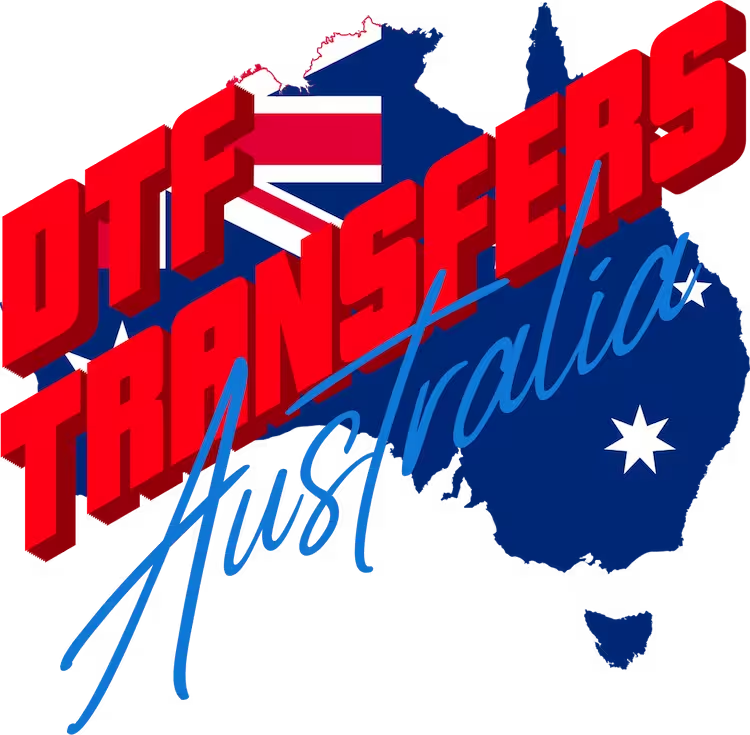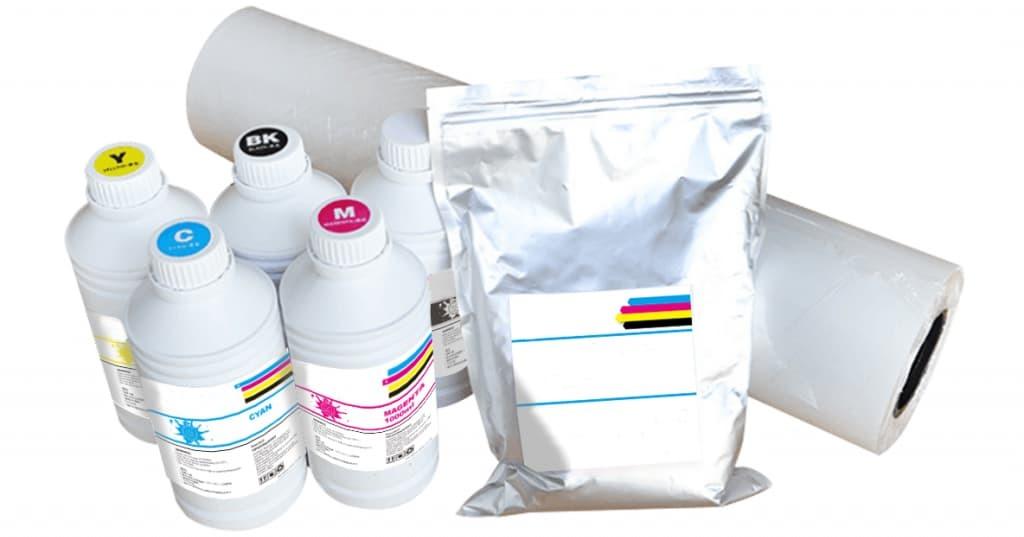All Posts, Printing Equipment
Not All DTF Transfer Inks Are The Same
Ever wonder why some custom printed shirts outshine others in colour vibrancy and longevity? Well, the secret is often hidden in the ink – more specifically, DTF transfer ink. You see, not all DTF transfer inks are the same.
Picture yourself at a marketplace of vibrant colours and unique designs on fabric everywhere you look. Each stall offers different shades of creativity but only a few stand out with an extra pop that draws your attention. This distinct charm comes from quality ingredients used during printing – it’s akin to how Michelin-starred chefs use quality produce for their culinary masterpieces.
In this colourful journey today, we’ll dive into what makes these high-quality inks so special compared to ordinary ones. We’ll explore how they can give your dtf prints longer life and unmatched brilliance while addressing the commonly asked questions about them.
Table Of Contents:
- What is DTF Transfer Printing?
- Why Choose DTF Transfers?
- What Makes DTF Transfers Different?
- What are the different types of inks used in DTF Printing?
- How Do I Choose the Right Ink?
- What Are The Benefits Of Using Quality Inks?
- Not all Transfer Manufacturers use Quality Inks
- Breaking New,Why Not All DTF Transfer Inks Are The Same
- FAQ’s About Why Not All DTF Transfer Inks Are The Same
- Is all DTF Ink the same?
- Do you need special ink for DTF transfers?
- Can I put DTF ink in my Epson printer?
- Whats the Difference between regular and DTF ink:
- Is all DTF powder the same?
- What ink do you use for DTF transfers?
- Can DTF transfers go on any color shirt?
- Can I print DTF with sublimation ink?
- Wrapping Up Why Not All DTF Transfer Inks Are The Same
- Conclusion
What is DTF Transfer Printing?
DTF (Direct to Film) transfer printing is a method of printing designs onto fabric using special inks and a heat press. The process involves several steps:
- Preparing your artwork
- Sending your artwork to the printer
- Printing the artwork using quality inks and transfer film, The Colour ink will print first followed by the white ink.
- Applying the adhesive powder
- Curing the transfer and the adhesive, (powder adhesive).
- Trimming the transfer ready for fitting
- Fitting the transfer with a heat press
- Peeling off excess material
- Doing a finishing press
Fitting: It’s All About Precision
Fitting requires trimming around edges of the transfer leaving 10 to 20 mm around the transfer. Now it is time to use your Heat Press to fit the Transfers. Here’s an excellent resource detailing how you can master fitting like a pro.
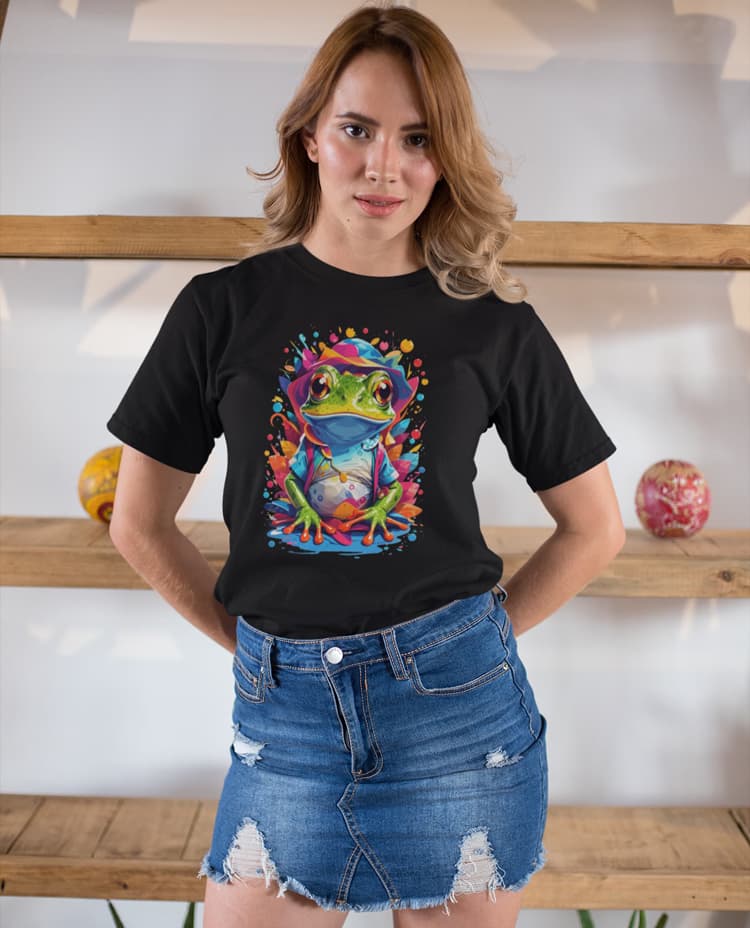
The Finishing Touches
After peeling off film after you complete your fitting comes yet another crucial stage: the finishing pressing gives that neat look everyone admires about a professional garment customisation jobs done using DTF transfers.
With DTF Transfer Printing, creating your custom apparel is not just efficient but also a fun and fulfilling process. And if you don’t own your own dtf printer, we can print your transfers for you.
Why Choose DTF Transfers?
If you’re looking for an economical way to produce custom printed apparel, DTF transfers are your go-to solution. But what sets them apart? They offer vibrant colours and sharp details that truly pop on most materials.
With traditional printing methods, certain materials were notoriously hard to print on. But with DTF transfers, this is no longer a hurdle. You can easily apply stunning designs onto most materials that have been difficult in the past such as cotton, polyester or blends. They can even be used on stretchy material like Lycra.
It is more important when fitting onto difficult materials to take into consideration that not all DTF transfer inks are the same and using Quality made transfers is paramount when fitting transfers to difficult material like Polyester and Lycra.
The Power of Versatility
DTF transfer printing, allows us at DTF Transfers Australia, to give our customers endless design possibilities. The method enables intricate patterns and detailed artwork without compromising on quality.
This flexibility makes it perfect for small businesses seeking unique branding solutions or individuals wanting personalised attire. Plus, its ability to handle high-volume orders efficiently means it’s equally suited for large-scale production runs as well.

Economical Without Compromising Quality
While being budget-friendly might imply lower quality elsewhere – not here. At DTF Transfers Australia, we don’t compromise when it comes to providing top quality products. Using superior-quality inks, we ensure each piece produced retains its vibrancy wash after wash.
To make things even better – these exceptional results come without the need for pre-treatment processes typically required by other techniques like DTG (Direct To Garment) printing. That means less time, effort and cost for you.
The Ease of Application
DTF transfers are incredibly user-friendly, too. The process is straightforward – just press the transfer onto your garment with a heat press, peel it off once fitted and voila. You’ve got yourself a custom piece ready to wear or sell.
If that sounds like something you’d want to try out – we’re here to help. Get in touch with us at DTF Transfers Australia today.
DTF transfers offer a cost-effective solution for vibrant, custom printed apparel on any material. Their versatility opens up endless design possibilities without compromising quality, making them ideal for both small businesses and large-scale production runs. Plus, the user-friendly application process eliminates pre-treatment steps often required by other techniques – saving you time and money.
What Makes DTF Transfers Different?
If you’re into custom printed apparel, you’ll know that not all printing methods are the same. But what about Direct to Film (DTF) transfers? What sets them apart?
The magic lies in the use of quality film, adhesive and most importantly – ink. The type and quality of ink used can dramatically affect your final product, and it is important to rember not all DTF transfer inks are the same, Using quality materials will make your transfers the best they can be.
Diving Deeper Into Inks And Why Not All DTF Transfer Inks Are The Same
Ink plays a critical role in any print process but is especially vital for DTF transfer printing. This method uses special inks which bond with adhesive powder during the curing process to create the transfer.
However, beware. Not all DTF transfer inks are created equal. Some manufacturers may cut corners by using sublimation inks instead of specially designed ink meant for DTF. These substitutes can lead to less vibrant colours and poor durability.
The Lowdown on DTG Inks
Direct To Garment (DTG) Inks, though commonly used for traditional direct-to-garment prints, also work great for DTF as well. They offer bright colours and excellent wash-fastness.
Specially formulated DTG inks help create high-quality transfers with stunning detail retention – a must-have feature if intricate designs or small text forms part of your artwork. DTG Ink also has a stretch to the ink that sublimation inks just don’t have.

Moving Towards Specialised Inks
To get superior results from your prints, choosing specialised DTF Transfer Ink is key. Its formulation is tailored to adhere optimally with the adhesive powder and transfer film used in DTF.
This ensures not just better print quality but also longevity, keeping your custom apparel looking fresh for longer. Isn’t it what we all desire – a lasting, high-quality look that will keep our custom apparel looking great?
To make sure you’re getting the best, always ask your supplier about their ink types before buying – it could save you a lot of disappointment down the line. Remember they will want to sell you what they stock and rember that not all DTF transfer inks are the same, so do some homework and do not just take their word on it.
What are the different types of inks used in DTF Printing?
In the world of Direct to Film (DTF) printing, ink choice plays a vital role. But not all inks can do justice to your design or fabric.
There’s an ocean full of choices, but three major players stand out – Sublimation Inks, DTG Inks and specially designed DTF Inks.
Sublimation Inks
Sublimation inks is often a popular pick for heat transfer prints due to their bright hues and crisp results. However, they come with limitations when it comes to material compatibility; only suitable for polyester fabrics or polymer-coated items. When using them on DTF Transfers that are going to be used on cotton or other materials they won’t yield satisfactory results because they are designed to become a part of the material. and when used to create the DTF transfers the adhesive lacks the polymers that bind with sublimation dyes during heating.
Another downside of using sublimation inks in creating DTF transfers is that the transfers lack the stretchiness of DTG and DTF inks.
Digital To Garment (DTG) Inks
The next contender is Direct To Garment (DTG) Ink. Unlike sublimations which work by dyeing fabric fibres, DTG works more like traditional printing where ink is applied directly onto textile surfaces creating highly detailed designs without limitation on colour usage. Although it has restricted versatility across various materials including polyesters and blends alike. When this Ink is used with a DTG Printers to create DTF Transfers the outcome can be outstanding, the colours will be vibrant and the longevity of the transfers will be very good.
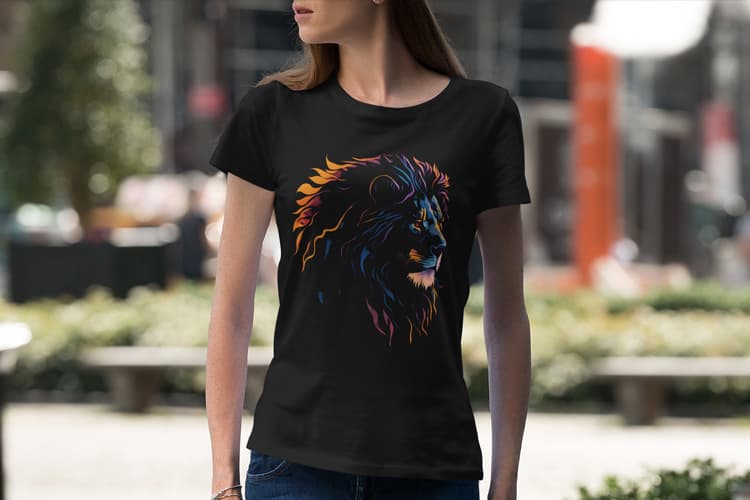
Specially Designed DTF Inks
Last but definitely not least are the specially designed DTF specific inks. Engineered exclusively for direct-to-fabric transfers process this type delivers vibrant colours regardless if you’re working with dark coloured fabrics something sublimation inks can struggle with. So, for versatility and vibrancy, DTF inks are the real deal.
Selecting a ink is akin to selecting your preferred ice cream flavour – there’s no definite answer, only what works for you. And when it comes to DTF printing, remember not all inks are created equal.
How Do I Choose the Right Ink?
Selecting the right ink for your DTF transfers is a crucial decision. It is essential to do your homework before obtaining a printer, as the kind you get may have an effect on what ink type you should pick or will have to use.
The key factor when choosing an ink is its compatibility with your printer. Some printers work better with certain types of inks and may even require specific ones for optimal results. Hence, familiarising yourself with what your device prefers can help avoid possible problems in the future.
When choosing how you are going to create your transfers it is just as important to think about the ink as it is about the equipment that you are purchasing.
Different Types Of Inks For DTF Printing
Ink selection also varies depending on whether you are using sublimation inks, specially designed DTF inks, or DTG (Direct To Garment) inks. Each has its unique characteristics which can impact print quality and durability differently:
- Sublimation Inks: These are generally not recommended because they tend to create transfers that crack over time.
- Specially Designed DTF Inks: They offer excellent colour saturation but might be more pricier than other options.
- DTG Inks: A popular choice due to their versatility and overall good performance on different materials.
Making The Right Choice
Beyond printer compatibility, consider factors such as cost-effectiveness, longevity of the print, and colour vibrancy. Each ink type has its pros and cons; thus it’s essential to weigh these factors based on your specific needs.
For instance, if you’re prioritising longevity over cost-effectiveness, choosing a high-quality DTF-specific ink might be worth the investment. Remember, quality inks can help ensure that your prints last longer and have better colour saturation than lower quality options.
Colour Profiling, this has long been a problem with DTF Transfers, it is normally a problem where the printed colour does not match the original file. This problem is normally associated with using mis-matched inks, software and hardware. When you are purchasing a printer it is wise to ask the question if there are any problems with Colour Profiling.
Choosing the right DTF transfer ink: It’s more than just picking one. Your printer type, cost-effectiveness, print longevity and colour vibrancy all play a part. And remember – quality inks can mean better prints that last longer.
What Are The Benefits Of Using Quality Inks?
When it comes to DTF transfers, the quality of ink used can make a significant difference in your final product. It’s much like using high-grade fuel for your car; you’ll get better performance and longevity.
Quality inks, specifically designed for DTF printing, ensure that your prints last longer. Lower quality or sub-standard inks might give immediate results but may fade quickly with time and washing, and they may even crack and peel.
Lasting Impressions with Vibrant Colours
A key advantage of premium inks is their superior colour saturation and vibrancy. These quality supplies breathe life into designs, producing crisp lines and rich hues that stand out even from afar.
Compare this effect to watching a film on an old television versus a state-of-the-art 4K screen – there’s simply no competition. With high-quality DTF transfer inks, every detail pops beautifully.
Say Goodbye To Fading Prints
Premium-quality DTF transfer ink has exceptional resistance against wash-related fading—a common problem associated with lower grade products. You want customers sporting vibrant graphics months after purchase—not washed-out tees within weeks.
The same way we wouldn’t expect cheap paint to withstand harsh weather conditions on our homes—similarly cheaper quality printer ink will not endure repeated laundering cycles and sun exposure well enough over time.
Friendly For Your Printing Equipment
Better-quality inks are also kinder to your printing equipment. They’re less likely to cause blockages or other issues, ensuring smooth operation and saving you time on maintenance—much like using the right oil in an engine for optimal performance.
So while they might seem more expensive upfront, their benefits in terms of product quality and longevity can actually make them a cost-effective choice over time.
Just one cloged print head can cost you hundreds to thousands of dollars, so is it really worth the savings in the long run if you keep having to replace the print head or you have to get the printer fixed.
Not all Transfer Manufacturers use Quality Inks
Quality is the heart of DTF transfers, and it starts with using the right ink. However, not every manufacturer of Custom Printed DTF Transfers holds to this principle. They might opt for cheaper alternatives that can compromise your final product.
You see, when you choose DTF Transfers Australia, we make sure to use only high-quality inks designed specifically for our DTF print process. It’s like baking a cake; you wouldn’t swap out quality ingredients for inferior ones if you want a delicious result.
The Issue with Sublimation Inks
Sublimation inks may seem like an attractive alternative due to their lower price point but don’t be fooled. Using sublimation inks for DTF printing is akin to putting diesel fuel into a petrol car – it simply won’t work as intended.
In fact, these types of ink lack the robustness required by methods such as DTF which could lead to fading or even washing off after just a few laundry cycles – definitely not what anyone wants.
Don’t get us wrong these inks work exceptionally well when used as they are intended, but they are just lacking when used for creating quality DTF Transfers.
Making the Right Ink Choice
If you own your own printer from known brands such as Roland or Mimaki, always stick with manufacturer-recommended inks because they are made precisely for that purpose. They will work seamlessly with the software and the printer.
We get it; finding reliable suppliers can feel like looking for a needle in a haystack sometimes. But fret no more. At DTF Transfers Australia, we’ve done all hard yards so our customers can sit back and focus on what they do best – creating amazing designs.
So next time you buy custom DTF transfers, remember to ask the question – are these transfers created using sublimation inks or designed for DTF ink? This small step could save a lot of trouble down the line.
Breaking New,Why Not All DTF Transfer Inks Are The Same
In the last month or so there has been a new technology has improvement in DTF Inks with the advent of the precipitation-free white ink, the main feature of this ink is that it no longer contains Titanium Dioxide. It is not possible to mix the new and the old inks together, but when purchasing a new printer it is worth considering that these new inks are available, and they have a huge advantage in reducing maintenance, and problems with print head clogs, the bain of DTF Printers for the longest time.
While this ink has currently only been developed for use in a dtf printer, we feel confidant it will make its way into all printing process that use White Ink like dtg printing as well.
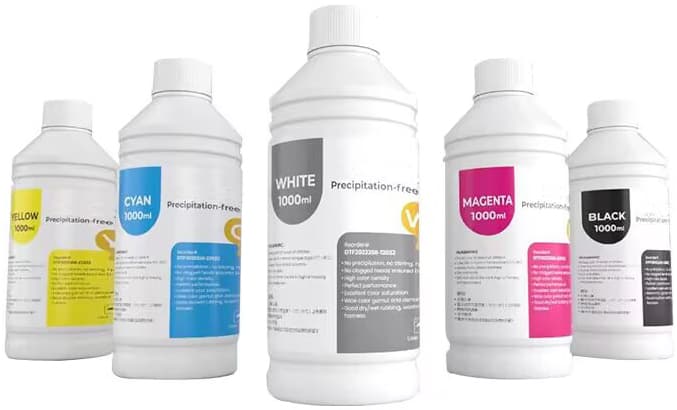
FAQ’s About Why Not All DTF Transfer Inks Are The Same
The world of DTF inks can be a bit confusing. But, don’t worry. We’re here to help clear things up for you.
Is all DTF Ink the same?
No, not at all. Just like how every baker has their own recipe for bread, each manufacturer uses different formulas for their DTF inks. These unique formulations result in varying levels of quality and performance.
Do you need special ink for DTF transfers?
Absolutely yes. Standard printer ink just won’t cut it when it comes to producing vibrant and durable designs on fabric. For best results with your custom printed t-shirts or other apparel items, we recommend using specially designed DTF and DTG Inks.
Can I put DTF ink in my Epson printer?
This is tricky because while technically possible, it might not give you optimal results unless your Epson model specifically supports DTF printing. It’s always best to check the user manual or consult an expert before trying this out.
Whats the Difference between regular and DTF ink:
In a nutshell, standard printer ink isn’t formulated to adhere well to fabrics or withstand washing as well as specific “Direct To Film” (DTF) transfer printing demands. This means that even if you could use regular print cartridges with DTF Film, the resulting print would be less vibrant and likely fade or washout over time.
Is all DTF powder the same?
No, not all DTF Adhesive powders are equal. The quality varies based on brand and manufacturing process which affects transfer results. Select quality materials to create your Transfers.
What ink do you use for DTF transfers?
We currently use the Brother Innobella inks to create our DTF Transfers, we have found that this gives us the best transfers using our software and equipment.
Can DTF transfers go on any color shirt?
Yes, one advantage of using a high-quality DTG or specific Designed DTF Inks is that they can be applied to shirts of any colour without losing vibrancy.
Can I print DTF with sublimation ink?
The answer technically is yes but, not really. While you can use sublimation inks for creating transfers, they are not designed to offer the same level of vibrancy or durability as dedicated DTF inks do. Always choose your ink based on what’s best for your project. Use Dye Sublimation Inks for Dye Sublimation.
Wrapping Up Why Not All DTF Transfer Inks Are The Same
We’ve delved into the world of DTF transfer printing, explored its merits and demystified how not all inks are created equal. From understanding what makes DTF transfers stand out to recognising the importance of using quality inks, we hope you’re now equipped with a better grasp on this topic.
The key takeaway? Quality matters. This is especially true when choosing your DTF transfer ink. The right ink can make or break your custom printed apparel’s durability, colour saturation and vibrancy.
In addition to that, it’s also essential to consider who manufactures your transfers. At DTF Transfers Australia, our commitment is unwavering – only Quality materials for an unbeatable end product. We pride ourselves on print DTF transfers for our customers that are crafted with exceptional care and expertise.
Why not take your apparel to the next level with Custom DTF Transfers from us at DTF Transfers Australia? It’s time to level up your apparel game by opting for high-quality Custom DTF Transfers from us at DTF Transfers Australia. With ready-to-press products made just for you – be prepared to impress your customers.
Conclusion
When it comes to vibrant, long-lasting prints, the secret’s in the ink. We’ve explored how not all DTF transfer inks are the same, and why quality matters.
You’ve learnt about different types of inks used for DTF transfers including sublimation and DTG Inks. And discovered that your printer can often dictate which ink you use.
We’ve underscored how using quality inks leads to better colour saturation and durability. Yet we cautioned against complacency; not all manufacturers prioritise quality when producing their transfers.
Lastly, you now have answers to some key questions around DTF printing. The takeaway? Do your homework before buying any ink or commissioning a print job!
If you want standout results every time, remember: choose wisely because not all dtf transfers are created using quality inks! Remember not all DTF transfer inks are the same.
Click here for custom DTF Transfers from us that promise high-quality at great prices!
